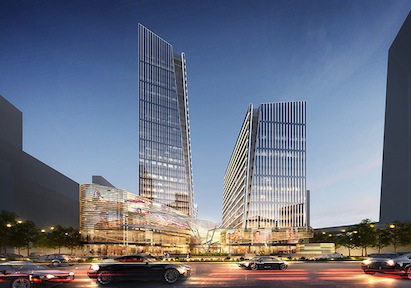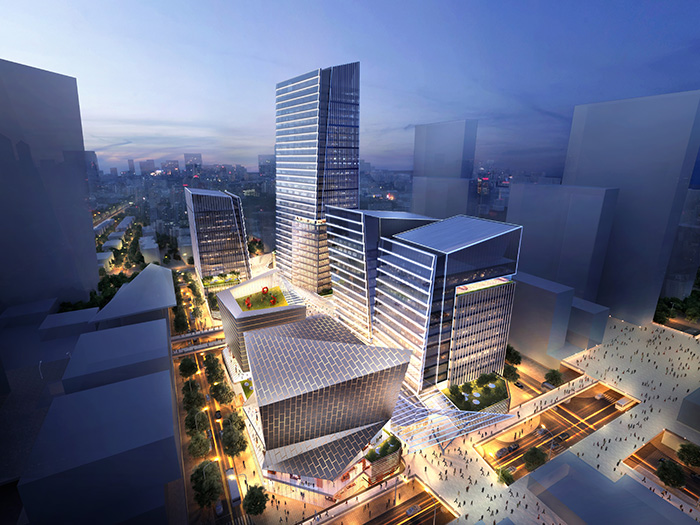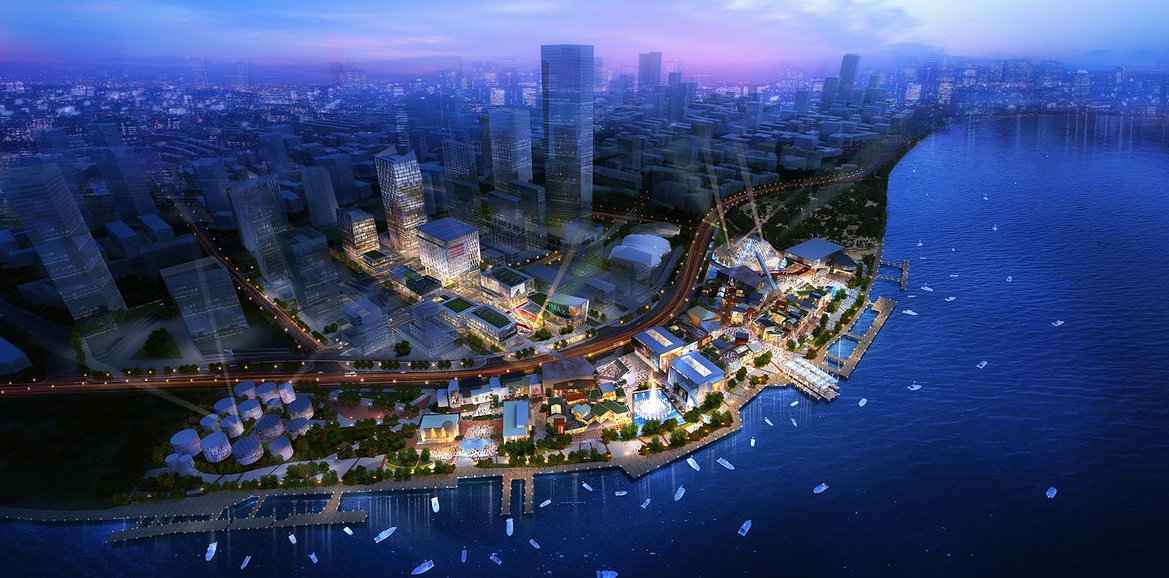International architecture firm Kohn Pedersen Fox Associates (KPF) is pleased to unveil designs for DreamWorks Asia Headquarters, Oriental Dreamworks and creative offices in the new Shanghai DreamCenter, which constitutes one of the most exciting projects in China.
Located along the riverside in Xuhui District, the 463,000-square-meter DreamCenter is an integrated cultural and lifestyle landmark that will feature performing arts spaces, creative media spaces, black box and imax theaters, as well as world-class entertainment, fashionable retail areas and premium restaurants and bars.
“Together with the West Bund Media Port, this will become the world’s third great urban center for entertainment and arts alongside New York’s Broadway and London’s West End,” said DreamWorks Animation CEO Jeffrey Katzenberg. With offices on New York’s 42nd Street and in London’s Covent Garden, KPF is quite literally ‘in’ show business and has come to know what makes such creative capitals tick. In the words of KPF Principal Paul Katz, “We also know first-hand the value of locating in such creative cores, for our process, our staff, and our work as architects.”
A collaboration between Hong Kong Lan Kwai Fong Group, DreamWorks Animation and Shanghai China Media Capital, the DreamCenter is the flagship project of Shanghai’s West Bund Media Port, a large-scale development focused on creative and digital media, technology, and cultural industries.
Katz commented, “We’ve watched Shanghai develop into a global city. And now, three visionaries, three of the most influential shapers of global culture in the 21st century are coming together to create its creative hub: Jeffrey Katzenberg, who heads one of the most influential studios in the industry; Allan Zeman, who has made such a huge contribution to Hong Kong, including the development of Lan Kwai Fong in HK and now China, which transformed the culture of public space and demonstrated a new respect for international lifestyle and world-class entertainment; and Li Ruigang, the visionary who has punctuated the evolution of China’s media and entertainment industry. In 20 years, Shanghai has transformed itself from an agrarian-based economy to one of the leading post-industrial economies in Asia. The DreamCenter project will further define Shanghai’s role as a global meeting-place for creative industry, technology, entertainment, and culture.”
Through the revitalization of the hundred-year-old former cement factory and other industrial artifacts into iconic creative live performance venues and F&B facilities, DreamCenter blends together the site’s industrial and cultural history with modern architecture, offering an unseen experience for the people of Shanghai and international tourists.
KPF’s two-block design represents the creative heart of the master plan—and its largest district. The eastern block is home to a pair of creative office towers, a theater building and arts building, whose open-air rooftop features a sculpture garden. The western block features a pair of towers (DreamCenter’s tallest), which angle slightly as they rise above this space, framing the views westward towards the DreamCenter and Huangpu Riverfront and creating “sky canyons” that capture the sky by day and emanate light and activity by night. At the base of the tower, the design includes a direct connection to the Shanghai Metro, a shared retail podium, and an elevated pedestrian walkway lined with shops and restaurants that extends eastward to connect the entire development.
Like KPF’s designs for Roppongi Hills in Tokyo, Hudson Yards in New York, and Covent Garden in London, Shanghai DreamCenter will become the great gathering place for the city, bringing together diverse activities, industries, and cultures, and enabling this energy and streetlife to radiate outwards, activating the city.
Construction of the Shanghai DreamCenter will begin this year and is expected to complete in 2017.
About Kohn Pedersen Fox Associates (KPF)
Kohn Pedersen Fox Associates (KPF) is one of the world’s pre-eminent architecture firms, providing architecture, interior, programming and masterplanning services for clients in both the public and private sectors. Operating as one firm with six global offices, KPF is led by 24 Principals and 27 Directors. The firm’s 600+ staff members come from 43 different countries, speak more than 30 languages and include over 80 LEED accredited professionals.
KPF’s diverse portfolio, which features over 70 projects certified or pursuing green building certification, comprises corporate, hospitality, residential, academic, civic, transportation and mixed-use projects located in more than 35 countries. The firm’s recent work includes the Abu Dhabi International Airport, the Shanghai World Financial Center, the International Commerce Centre in Hong Kong, New Songdo City in Korea, the Mandarin Oriental Las Vegas, the RBC Centre and Ritz? Carlton in Toronto, and Heron Tower, Sixty London and Unilever House in London.
Related Stories
| Dec 7, 2010
Product of the Week: Petersen Aluminum’s column covers used in IBM’S new offices
IBM’s new offices at Dulles Station West in Herndon, Va., utilized Petersen’s PAC-1000 F Flush Series column covers. The columns are within the office’s Mobility Area, which is designed for a mobile workforce looking for quick in-and-out work space. The majority of workspaces in the office are unassigned and intended to be used on a temporary basis.
| Dec 6, 2010
Honeywell survey
Rising energy costs and a tough economic climate have forced the nation’s school districts to defer facility maintenance and delay construction projects, but they have also encouraged districts to pursue green initiatives, according to Honeywell’s second annual “School Energy and Environment Survey.”
| Dec 2, 2010
GKV Architects wins best guest room design award for Park Hyatt Istanbul
Gerner Kronick + Valcarcel, Architects, PC won the prestigious Gold Key Award for Excellence in Hospitality Design for best guest room, Park Hyatt Macka Palas, Istanbul, Turkey. Park Hyatt Maçka Palace marries historic and exotic elements with modern and luxurious, creating a unique space perpetuating Istanbul’s current culture. In addition to the façade restoration, GKV Architects designed 85 guestrooms, five penthouse suites, an ultra-hip rooftop bar, and a first-of-its-kind for Istanbul – a steakhouse, for the luxury hotel.
| Dec 2, 2010
U.S Energy Secretary Chu announces $21 Million to improve energy use in commercial buildings
U.S. Energy Secretary Steven Chu announced that 24 projects are receiving a total of $21 million in technical assistance to dramatically reduce the energy used in their commercial buildings. This initiative will connect commercial building owners and operators with multidisciplinary teams including researchers at DOE's National Laboratories and private sector building experts. The teams will design, construct, measure, and test low-energy building plans, and will help accelerate the deployment of cost-effective energy-saving measures in commercial buildings across the United States.
| Nov 29, 2010
Data Centers: Keeping Energy, Security in Check
Power consumption for data centers doubled from 2000 and 2006, and it is anticipated to double again by 2011, making these mission-critical facilities the nation’s largest commercial user of electric power. Major technology companies, notably Hewlett-Packard, Cisco Systems, and International Business Machines, are investing heavily in new data centers. HP, which acquired technology services provider EDS in 2008, announced in June that it would be closing many of its older data centers and would be building new, more highly optimized centers around the world.
| Nov 29, 2010
New Design Concepts for Elementary and Secondary Schools
Hard hit by the economy, new construction in the K-12 sector has slowed considerably over the past year. Yet innovation has continued, along with renovations and expansions. Today, Building Teams are showing a keener focus on sustainable design, as well as ways to improve indoor environmental quality (IEQ), daylighting, and low-maintenance finishes such as flooring.
| Nov 29, 2010
Renovating for Sustainability
Motivated by the prospect of increased property values, reduced utility bills, and an interest in jumping on the sustainability bandwagon, a noted upturn in green building upgrades is helping designers and real estate developers stay busy while waiting for the economy to recover. In fact, many of the larger property management outfits have set up teams to undertake projects seeking LEED for Existing Buildings: Operations & Maintenance (LEED-EBOM, also referred to as LEED-EB), a certification by the U.S. Green Building Council.
| Nov 23, 2010
The George W. Bush Presidential Center, which will house the former president’s library
The George W. Bush Presidential Center, which will house the former president’s library and museum, plus the Bush Institute, is aiming for LEED Platinum. The 226,565-sf center, located at Southern Methodist University, in Dallas, was designed by architect Robert A.M. Stern and landscape architect Michael Van Valkenburgh.
| Nov 23, 2010
Honeywell's School Energy and Environment Survey: 68% of districts delayed or eliminated improvements because of economy
Results of Honeywell's second annual “School Energy and Environment Survey” reveal that almost 90% of school leaders see a direct link between the quality and performance of school facilities, and student achievement. However, districts face several obstacles when it comes to keeping their buildings up to date and well maintained. For example, 68% of school districts have either delayed or eliminated building improvements in response to the economic downturn.

















